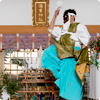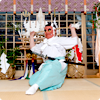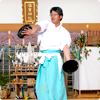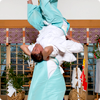
Nationally Designated Important Intangible Folk Cultural Property of Japan
Iki Kagura
“Iki Kagura” is a 700 year old traditional Shinto performance, and a nationally designated important intangible folk cultural property. Different from the Kagura traditions in other regions, the individuals who dance and play the music in Iki’s Kagura must be part of the Shinto priesthood in order to perform; because of this exclusivity, it is considered to be a very sacred and valuable cultural asset. The songs do not have written records, and instead are passed down orally, and the dance is conducted in a mere space of two tatami mats. From autumn through winter, there are Kagura performances nearly every day in each of the island’s shrines.
Daidai-Kagura “Grand Kagura Performance”
The 6 hour performance happens only twice a year, during August and December.
● August – 1st Saturday of the month
@ Tsutsukihama Beach Fureai Hiroba / 18:00
This performance is conducted at the “Fureai Hiroba,” located near the Tsutsukihama beach.
In one act, fitting for an island community, tourists and fishermen who come up onto the stage are covered with a large net in a prayer for safety on the seas.
● December 20 @ Sumiyoshi Shrine / 14:00 ~
Amidst the cold evening air, the place is lit up green and wrapped in a mysterious atmosphere.
[ Watch a video ] https://youtu.be/MOUc9ghGy8I
Major Performances
There are 33 performances (35 including extras) that make up the Iki Kagura.

[ Yatagarasu ]
This Kagura praises the noble achievements of Yatagarasu, a mythical three-legged crow. Yatagarasu was sent by the gods as a guide and oracle for Emperor Jinmu on his journey eastward as he searched for an appropriate location for administering the nation.

[ Sarutahiko ]
In Japanese mythology there is a legend called Tenson-korin that tells the story of the descent of Amaterasu’s grandson Ninigi from the heavens to Japan. The way down is difficult, and Sarutahiko comes to guide Ninigi; this Kagura praises his great deeds.

[ Oshiki ]
This Kagura is a prayer for the gods to look over the people; the performance dances while balancing serving trays called oshiki.

[ Kamizumo ]
Sumo wrestling is Japan’s national sport; performers demonstrate sumo techniques in front of the gods. This Kagura is a prayer for strength and good health in both mind and body.
Inquiries
( Nationally Designated Important Intangible Folk Cultural Property of Japan )
Iki Kagura Preservation Association (470-1 Sumiyoshi Higashi-fure, Ashibe-cho, Iki-shi)
TEL:0920-45-3002
Kagura Masks
Dances that use masks express the appearance of a god. From ancient times, Kagura masks have beenused in the performances for Yatagarasu, Sarutahiko, and Uzume. In recent years, masks are also used in the “Honen-mai” dance, so you can enjoy them in 4 performances.
-
Sarutahiko
The god that guided all of the others when they came down to the earth. Appropriately, Sarutahiko has strong, powerful, facial features.
-
Yatagarasu
A mythical three-legged crow that served as a guide and for Emperor Jinmu. Piercing eyes and a sharp beak give this mask a powerful appearance.
-
Uzume
The goddess that came to meet Sarutahiko. Symmetrical facial features and cool, clear eyes; this mask has kind, gentle features.
-
Ajime
A plump face, with cute, friendly features.
-
Okina
Used in a dance called “Honen-mai,” this mask has a countenance brimming with delight, in gratitude of the blessings of the gods.







